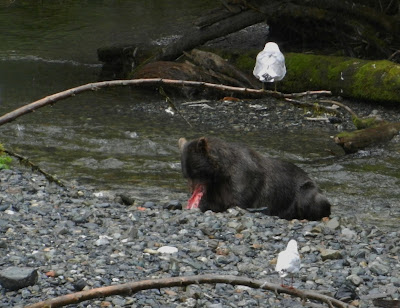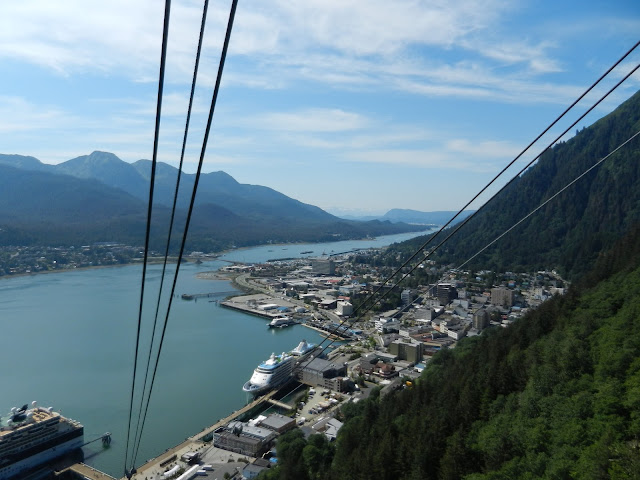 |
| A Beautiful Classic at Pack Creek |
A beautiful classic wooden boat had
come into the bay to anchor on the last night of our stay at Pack Creek. Passengers gathered in the fantail of the
ship for the evening’s social hour or perhaps for a meeting to prepare for
their Pack Creek experience the following day.
We left the anchorage in the morning at 8:30 and headed back south along
Seymour Canal motoring with one engine.
We have made a new practice of running on only one engine as we depart and
arrive at an anchorage site which helps save on engine hours and reduces our
speed.
After exiting the bay, we started
the second engine and noted that the low voltage alarm was chirping and that
the meter (battery monitor) was not showing a charge. Leonard surmised that the problem could be
one of two scenarios: the alternator(s)
were not providing DC charging (one alternator per engine), or the “smart
controller board” (circuit board) was defective. He reasoned that it was unlikely that both
alternators would go out at the same time.
Going to the engine room, he looked at the “smart board,” which
electronically controls the amount of charging that the engine alternators are
putting out, and noted that the three LED lights on the circuit board were not
lit; ah ha, it must be a fuse - good thing we carry spares. He replaced the deteriorated fuse and we were
back in business. This little fuse has
now been added to the list of scheduled maintenance items, something to be
replaced after every 2,000 hours of motoring.
As someone once said, “cruising is all about working on your boat in
exotic places.” After spending about 30
minutes, we were on our way again, riding choppy 2-foot seas under overcast skies. We reached Stephens Passage around noon where
we saw several whales. As we approached
Bill Point on Whitney Island, numerous whales were seen in all directions, another great
spot for excellent whale watching. In
fact we saw a couple of tour boats in the area along with their smaller skiffs for
a more adventuresome, close-up look at the whales. The nearby small islands, including “Five
Fingers” and the changing current no doubt create a favorable feeding
ground for the whales and opportunities for boaters to see these magnificent
creatures.
We motored past the tour
boats into Cleveland Passage, an anchorage tucked behind Whitney Island off
mainland Alaska and set our hook for the night.
Cleveland Passage was once the site of a Fox Farm and pilings from the
docks can still be seen along the shore.
The following morning we rounded Cape Fanshaw and entered Frederick
Sound heading southeast. As we neared Petersburg,
the sun shone through the clouds and we could see Baird Glacier in the
distance.
The seas had flattened to a
gentle ripple, but we would soon be entering the narrow passage into Petersburg
where the current would be running at a swift pace. Sea Lions were sunning themselves on the
channel markers as Petersburg came into view.
Further down the channel, we could see that a fishing boat had gone aground along the shore;
an ominous reminder to keep a vigilant watch and not leave your boat unattended
while anchored in the swift moving waters of this channel.
As we
approached the marina docks, we radioed our request for a slip assignment where
we would spend the next ten nights at this Southeast Alaska home away from home.
 |
| "Smart Controller Board" (circuit board) on Got d' Fever |
 |
| Baird Glacier north of Petersburg |
 |
| Sea Lions on a Channel Marker near Petersburg |
 |
| Fishing Boat Aground, Petersburg |
 |
| Petersburg |



















































